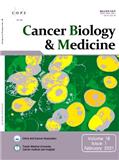| 投稿方式:官网投稿 |
- 栏目频次
- 单位占比
-
热词

高频栏目
中频栏目
低频栏目
-
更多
期刊简介
- 《癌症生物学与医学(英文版)》(Cancer Biology & Medicine)(月刊),创刊于2004年,是由中国科学技术协会主管,中国抗癌协会、天津医科大学肿瘤医院主办医学类学术刊物。
-
基本信息
- 期刊名称:癌症生物学与医学(英文版)(Cancer Biology & Medicine)
- 主管单位:中国科学技术协会
- 主办单位:中国抗癌协会、天津医科大学肿瘤医院
- 国内刊号:CN 12-1431/R
- 国际刊号:ISSN 2095-3941
-
- 出刊日期:
- 期刊定价:
-
- 邮发代码:
-
- 所在省区:天津
- 邮政编码:
- 联系地址:
-
投稿信息
-
- 学科分类:肿瘤学
- 版面费用:待核实
-
- 字数要求:10000-76000
- 查重要求:-
-
- 复合因子:2.102
- 综合因子:1.587
-
- 审 稿 费:待核实
- 稿费:待核实
- 本刊可发:
- 特殊属性:第一批认定学术期刊
-
联系方式
- 投稿网址:http://www.cancerbiomed.org/
- 官网网址:http://www.cancerbiomed.org/
- 电话传真:022-23522919(202101期)
- 电子邮箱:editor@cancerbiomed.org(202101期)
- 微信公众号:

